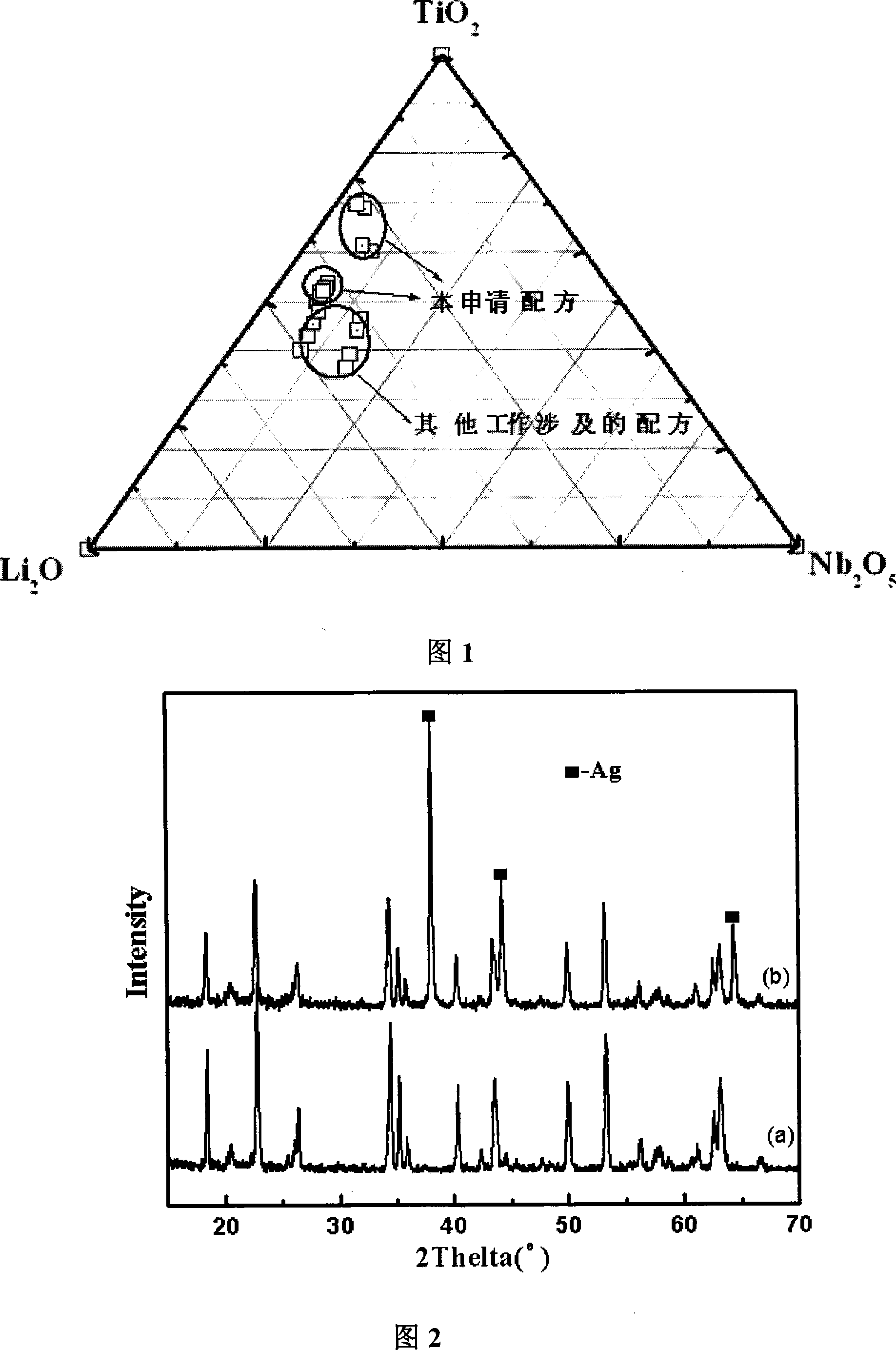Low-temperature sintered LTCC microwave dielectric ceramics material and preparation method thereof
A technology of microwave dielectric ceramics and low-temperature sintering, which is applied in the field of electronic ceramics and its manufacturing, can solve the problems of reducing the size of microwave circuits, etc., and achieve the effects of excellent microwave performance, low inherent sintering temperature, and large dielectric constant
- Summary
- Abstract
- Description
- Claims
- Application Information
AI Technical Summary
Problems solved by technology
Method used
Image
Examples
preparation example Construction
[0043] The above-mentioned low-temperature sintered microwave dielectric ceramic material and its preparation method. Specific steps are as follows:
[0044] 1) The raw material Li 2 CO 3 , Nb 2 o 5 、TiO 2 Moore Billy 2 CO3 : Nb 2 o 5 :TiO 2 = x: 1: y preparation, wherein 5.51+m-n Nb 1-m-3n Ti m+4n o 3 , where 0.1≤m≤0.15, 0.2≤n≤0.25,;
[0045] 2) Mix the prepared chemical raw materials, add alcohol according to the material: alcohol ratio of 1:2, put it into a nylon tank for ball milling for 4 to 8 hours, take it out and dry it at 120°C to 140°C, sieve it and press it into Place the block in an alumina crucible, raise the temperature to 800°C-900°C at a rate of 5°C / min, and keep it warm for 4h-8h to obtain a sintered block.
[0046] 3) Pulverize the sintered block, carry out secondary ball milling and drying for 4-5 hours, and granulate to obtain porcelain material, which is sintered at 1050°C-1150°C for 2-4 hours to obtain low-temperature sintered LTCC Microwave...
Embodiment 1
[0050] The chemical raw material Li 2 CO 3 , Nb 2 o 5 and TiO 2 Moore Billy 2 CO 3 : Nb 2 o 5 :TiO 2 =5.5:1:7 After the preparation, fully mix and ball mill for 4 hours, after grinding, dry at 120°C-140°C, sieve, press into a block, put it in an alumina crucible, and heat it at 5°C / min Raise the heating rate to 900°C, keep it warm for 8 hours, then pulverize the burnt block, ball mill it for the second time, take it out and dry it, then granulate it, and then sieve it with a 70 mesh and 120 mesh screen to obtain the desired ceramic material . After the ceramic material is pressed into shape (sheet or column) as required, and then sintered at 1050°C to 1150°C for 4 hours, the low-temperature sintered LTCC microwave dielectric ceramic material can be obtained. The microwave properties of the material at different sintering temperatures are shown in Table 1.
[0051] Microwave performance under table 1 embodiment 1 different sintering temperatures
[0052] Si...
Embodiment 2
[0054] The chemical raw material Li 2 CO 3 , Nb 2 o 5 and TiO 2 Moore Billy 2 CO 3 : Nb 2 o 5 :TiO 2 =5.5:1:7.5 After the preparation, fully mix and ball mill for 4 hours, grind and dry, sieve, press into a block, put it in an alumina crucible, and raise the temperature to 900°C at a rate of 5°C / min , keep warm for 8 hours, then crush the burnt block, ball mill it for the second time, take it out, dry it and granulate it, and then sieve it with 70-mesh and 120-mesh sieves to obtain the desired ceramic material. After the ceramic material is pressed into shape (sheet or column) as required, and then sintered at 1050°C to 1150°C, a low-temperature sintered LTCC microwave dielectric ceramic material can be obtained. The microwave properties of the material at different sintering temperatures are shown in Table 2.
[0055] Table two: Microwave performance under different sintering temperatures of embodiment 2
[0056] Sintering temperature
PUM
| Property | Measurement | Unit |
|---|---|---|
| sintering temperature | aaaaa | aaaaa |
Abstract
Description
Claims
Application Information
 Login to View More
Login to View More - R&D
- Intellectual Property
- Life Sciences
- Materials
- Tech Scout
- Unparalleled Data Quality
- Higher Quality Content
- 60% Fewer Hallucinations
Browse by: Latest US Patents, China's latest patents, Technical Efficacy Thesaurus, Application Domain, Technology Topic, Popular Technical Reports.
© 2025 PatSnap. All rights reserved.Legal|Privacy policy|Modern Slavery Act Transparency Statement|Sitemap|About US| Contact US: help@patsnap.com



